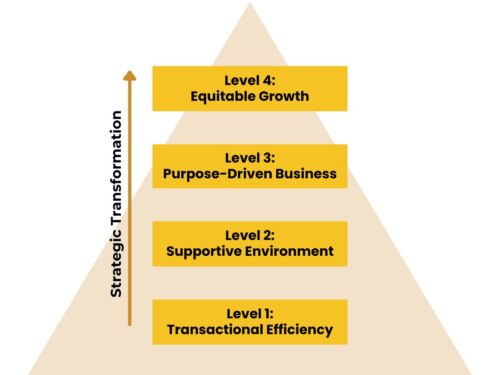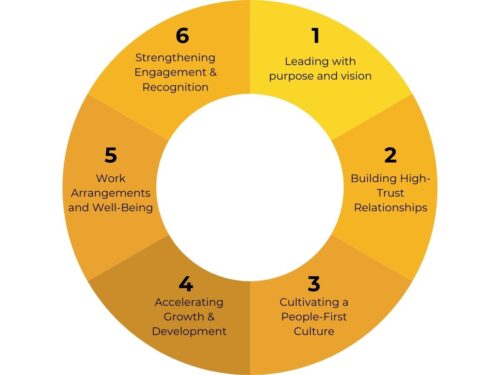Transformations Need Rethinking
What transformation is underway to make your business more successful? Whether you are seeking to unlock new market opportunities, pursue growth, shift how you deliver value to your customers or create new efficiencies, consider the following realities:
- To keep up with rapidly evolving business contexts, the pace of organizational transformations has accelerated;
- According to an EY study, 85% of leaders have been involved in more than two major business transformations in the past five years and;
- 82% believe these will become more frequent and impactful.
But yet, 70% of transformations fail or underperform.
Why is that? Put simply, transformations repeatedly fail because they don’t account for the human dimension of implementing transformation.
A common blind spot for businesses and leaders as they undertake efforts to transform their enterprise is the lack of design and planning for employee experience. In other words, top-down systemic initiatives must be matched with a bottom-up workforce experience design. Think of this as designing for the human operating system that is actually responsible for accomplishing the work.
What is Employee Experience?
In brief, employee experience (EX) takes a human-centered lens for all aspects of the work experience and lifecycle: sense of purpose, workplace culture, leadership, capability growth, workflow and technology enablement.
This is different than employee engagement which tends to be a measure of how the workforce feels about the company at a certain point in time. The former is transformative and the latter is transactional.
If your business is planning for transformation, it is essential to design a powerful employee experience to deliver on the promised objectives.
Why is Employee Experience Overlooked?
hy is it that businesses often overlook human-centered design in their business transformations? There are a few reoccurring reasons:
- Business and operational leaders focus on strategy and executing operational plans without a deep enough understanding of the importance of human dimensions for implementation.
- The HR function is not set up to design the workforce of the future and only has capabilities to deliver on compliance, organizational structure, hiring and training.
- There is an assumption that tactical change management techniques alone will solve buy-in and adoption issues that may arise within a workforce.
- Human-centered components of a transformation are seen as a ‘nice-to-have’ since it’s assumed that there is little to no business benefit to employee experience.
- Many executives themselves have had minimal experience developing human-centered transformation within organizations.
Employee Experience Drives ROI for Business Transformations
Research consistently shows the link between employee experience and business success.
A 2022 EY and Oxford Business School study shows that organizations that made human-centered design a focal point were 2.5 times more likely to be successful than those who don’t.
A recent Harvard study that shows when businesses move to the top quartile in employee experience metrics, they increase their revenue by more than 50%, and profits by nearly as much.
Consider the cost of employee attrition. McKinsey contends that many businesses don’t know how to solve their retention challenges because they don’t have insights into what their employees value. If they had a line of sight to the areas that matter most and focused their actions accordingly, they could cut attrition rates by 50%.
While compensation and benefits are important, research indicates that top talent is looking for additional benefits such as a positive and supportive culture, a deep sense of purpose or belonging, as well as flexibility when it’s needed.
Workplace Cultures Have Been Hollowed Out
An executive recently expressed the challenge of working in hybrid and remote environments: “It’s so hard to build momentum when each discussion is carried out almost exclusively online. Our conversations seem isolated and fragmented and it’s more difficult to get a sense of how what we are doing in one part of the business fits into the big picture.”
Put simply, remote work has made culture-building more difficult because fewer group experiences model the values of the organization. Businesses are fundamentally relying on the capability of leaders to model the culture largely through digital engagement. If leaders excel in leading in a digital environment, the employee experience can mature, but if not, the culture can deteriorate quickly. The result is a patchwork of company culture that is largely dependent on how teams engage based on the competencies of their leaders.
When workplaces had more consistent in-person experiences, culture could be “caught” as much as it was “taught.” Employees observe more activity and interact in informal and serendipitous ways. All of this catalyzes human bonding and gives employees a sense of belonging.
Even for many workplaces where in-person work is a consistent reality, there has been a steady erosion of culture. Rapid turnover in recent years may have slowed, but many businesses still lack a cohesive strategy to build loyalty and struggle to cultivate a deep sense of belonging and appreciation, all of which instill pride in their workforce and improve business performance.
Step Change Requires Strategic Human-Centered Investments
To deliver business transformation through employee experience, it is important to understand what a maturity path for employee experience could look like. The John Bersin Company has outlined four levels of maturity in employee experience:

Level 1: Transactional Efficiency
- Employees work in siloes and compete with each other
- HR plays the role of policy enforcer and legal police
- Technology is used as a tool to automate transactions and is thrown at people randomly
- Leaders focus primarily on minimizing cost and maximizing financial success.
Level 2: Supportive Environment
- Employees work together well and minimize conflict
- HR functions as the helper for employees and managers
- Technology helps enable employee collaboration and communication
- Leaders focus on financial performance and customer success.
Level 3: Purpose-Driven Business
- Employees bring creative new solutions for future business issues
- HR serves as an enabler of innovation and experimentation
- Technology enables personalization, growth, inclusion, and a sense of belonging
- Leaders balance financial, customer, people, and innovation outcomes effectively.
Level 4: Equitable Growth
- Employees work hard to solve customer problems
- HR empowers employee productivity and grows leadership capabilities
- Technology serves as a support system to power people’s work
- Leaders are accountable for financial, customer, and people success.
Articulate Your EX Strategy
The best practice for designing an EX journey is to map it onto the business transformation so the two are mutually reinforcing. While Level 4 may seem like the ‘holy grail,’ it is more likely and achievable for companies to advance from Level 1 to Level 3 over time. This journey requires investment and various enterprise strategies to work in tandem to achieve success.
A few key practices to engage in:
- Ensure the EX strategy has a clear vision and measurable objectives
- Develop and visualize employee journeys that clarify employee experiences
- Ensure the EX strategy is integrated with transformation teams and implementation strategies
- Adopt a posture of learning with tight feedback loops to iterate along the way
Implementing an EX Journey with a People-Centered Ecosystem
Once the EX journey has been designed and mapped onto the business transformation, implementation is driven by six people-centered components as shown below:

1. Leading with Purpose and Vision
A fundamental human need for all employees is to know that their work matters. We believe it is a ‘right’ for all employees to know that their work matters and to understand how their work connects to the mission and bottom line of the company. Employees crave meaningful work and companies that have a clear link between work and meaning-making have stronger employee retention and engagement.
Is your business ‘why’ compelling, and if so, can your employees connect this ‘why’ to their own reason for working for your company?
2. High Trust Relationships
Businesses experience flow when trust across the organization is strong. It’s essential to proactively grow trust to prepare for times of transformation.
In one global bank, business and technology teams working together on credit card products struggled to deliver on critical projects. Tensions and friction arose as the teams operated with very different approaches and mindsets. However, designing an experience for teams to work through tensions and humanize their relationship by identifying shared mindsets about how to do the work multiplied their impact and increased their business effectiveness by almost 30%.
3. Cultivating a People-First Culture
Edgar Schein, celebrated MIT organizational design theorist, suggested that the last half century has focused on the ‘boxes’ or the roles and structure of the organization. In the decades ahead, he said that the focus needs to be on the lines between the boxes, which are the relationships among the people who inhabit those roles.
A people-first culture is a mindset with a fundamental belief that people, not merely ‘roles,’ ultimately deliver success. This approach emphasizes that the company’s success is directly linked to the fulfillment and deep engagement of its employees. This mindset places a focus on creating open lines of communication, psychological safety, and optimizing the autonomy of employees to deliver well on key targets.
4. Accelerating Growth and Development
Employees will be more attracted and loyal to organizations that cultivate talent, and businesses will benefit by maturing their overall capabilities. By investing in developing high-potential employees in particular, companies can create stronger bonds with their top talent and increase the likelihood of retaining their best people for future critical roles.
In addition, the more a learning culture exists across the organization, the better positioned the company will be to drive new innovation.
5. Work Arrangements and Well-Being
Investment in employee well-being has been an area of focus for many businesses, but well-being is far more than a better benefit package or yoga classes. This focus considers the overall conditions of support, particularly inside the company, and how workplace environments including hybrid or remote work contribute to the well-being and effectiveness of the employee. Recently, one business articulated the value of in-office work as being together with the teams you work closest with. As a result, teams were asked to come back into the office for a set day that clearly added value to the work of the teams.
6. Strengthening Engagement and Recognition
Gallop recently reported that employees who receive great recognition are 20 times more likely to be engaged than those who are not sufficiently recognized. In addition, research shows that over 70% of their recognition experiences are related to the “little things”. As leaders adopt a culture of appreciation, businesses benefit because employees are inspired to bring their best efforts, including discretionary time, to their work.
Employee Experience is Key for Successful Transformation
Thriving businesses recognize that investing in employee experience not only fosters a strong workplace culture and leads to tangible organizational outcomes, but also creates successful business transformation. In today’s competitive landscape, where talent acquisition and retention are key differentiators, organizations cannot afford to overlook the significance of employee experience. By creating a human-centered workplace where employees feel respected, supported, and empowered, companies can unlock a host of benefits. It’s clear that prioritizing the employee experience isn’t just a nice-to-have—it’s a must for any business serious about staying competitive and succeeding through transformation.
